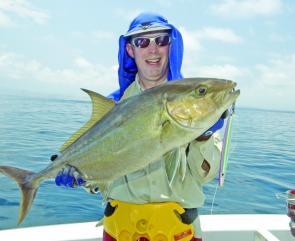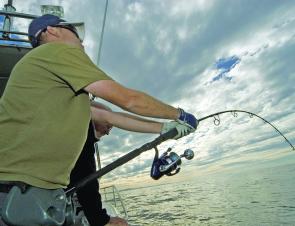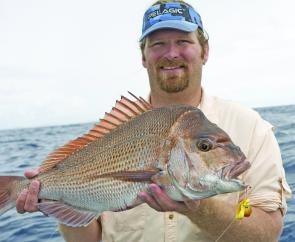The thing that keeps me coming back for more jig fishing is that sudden, out of the blue strike that takes you totally by surprise. A lot of the fish we target in Queensland on jigs are pretty determined to blast you straight back into the bottom, so the fight is won or lost within the first 30 seconds. This can put an enormous strain on the tackle so it is important to use gear that is up to the task.
The rods, reels and lines needed for jigging can be somewhat bewildering to the newcomer. The rods in particular have tapers quite different to what is most commonly used in Australia and many of the lines are rated differently to what we are used to locally. That said, the basic ideas are pretty simple as to how and why it all goes to together.
Jig rods are typically short, mostly under 6’ long and some under 5’ for really deepwater work. The taper usually ranges from moderate to quite parabolic (loads continuously from tip to butt). This contrasts strongly with the fast taper rods that most of us use for other fishing styles.
The progressive loading of the rod helps to give a consistent action to the lure and cushions the braid as the fish shakes its head. Having a short rod makes it easier for the angler to work the lure for longer periods of time and puts maximum pressure on the fish for the least amount of angler effort. Most jig rods have quite a long butt section so that they can be tucked under the arm easily when working the lures. When you first start looking at jig rods, they often look a bit puny compared to other offshore rods but they pack a pretty big punch for their size.
Rods are rated by the line class they are intended to fish, as well as the jig weights they are designed for. A lot of rods, especially those from Japan are given a PE rating (PE = polyethylene, the stuff that braid is made from). In a standard quality PE line, PE4 = 40lb, PE5 = 50lb and so on. In recent times, lines have become thinner so now PE4 can be 60lb and PE5 can have a 75lb breaking strain. This makes things pretty confusing, so if you’re buying a jig outfit, ask the salesperson what line they recommend for the rod and, better still, get them to load it up so that you can feel it for yourself.
There are a bunch of good jig rods going around these days; we really are spoiled for choice. At the cheaper end of the spectrum there are rods like the Silstars and Berkley Dropshots, in the mid to upper range there are several excellent models from Daiwa and Shimano, while at the upper end are numerous boutique brands such as Smith Ltd, Zenaq, Patriot Design, Carpenter and Ripple Fisher, just to name a few.
The kind of reels best suited to jigging varies a lot depending on the amount of line and drag pressure that is needed for the task. Two things that are common to all is that, firstly, jig reels do a lot of winding, so top quality gears are needed and, secondly, small compact reels are easier to jig with for long periods than big heavy ones. Ideally what you are looking for is the smallest, lightest, strongest reel you can afford.
Depending on the situation, I have used everything from a small Millionaire baitcaster, which is better suited to bass fishing, through to a Saltiga spooled with 120lb braid. If you’re trying to figure out whether to spend more money on either a jig rod or reel, I’d say put the money into the reel every time. They really do get a lot of punishment, especially in the larger sizes.
Poor quality gear generally doesn’t break on ordinary fish; instead it sits and waits for the fish of a lifetime to come along. With a broken rod you still stand half a chance of landing the fish but with a busted reel you’ve got next to none.
Gear ratios for jigging causes a fair amount of debate, but most anglers prefer reels with moderate retrieve speeds as it is the rod that makes the lure move rather than the reel. A slower speed reel does a much more efficient job at winching big fish off the bottom than their higher speed counterparts.
The decision on whether to fish spin or overhead is a personal one. I really like jigging with overheads but I find myself using spin gear more often as I can use the reel for a wider variety of other applications.
Another thing worth considering is the gunnel height of the boat you fish on. Some people find it easier to use overhead reels on boats with high gunnels as it leads to less unexpected collisions between tackle and boat. If you are looking at buying an overhead, consider many of the narrow spooled models now available as they tend to balance a lot better when cranking a jig up fast.
In terms of brands and models of reels, there is a mountain of gear to choose from. In the smaller sizes there are many reels that will do the job. Moving up into larger sizes, reels from Daiwa such as Saltists and Catalinas are popular choices while Shimano’s Spheros, Saragossa and Trinidad are also top reels. Once you move into the very heavy-duty reels where 10-15kg drags and above are needed, the field narrows considerably. Overheads such as Daiwa Saltigas and Shimano Torsas are excellent reels, while in spin it comes down to a choice of Shimano Stella or Daiwa Saltiga.
While these big spin reels are expensive, they are simply the only reels to use for super heavy-duty work where massive drag capacity, strength and durability are needed for huge amberjack, kingfish, samson and big tuna.
There is probably not much that I can say about braid that hasn’t already been said at some time or other in this magazine. Generally, the greater the number of threads used to make the line (up to 8) and the tighter they are woven together, the thinner and more expensive the braid will be.
Colour coded markings are great as it can give you excellent awareness of where your jig is in relation to the bottom and can remind you to stop jigging too far up the water column when targeting bottom dwellers. For lighter jigging in south east Queensland for snapper, pearlies and the odd kingfish, 20-40lb braid is fine. If you are putting together a ‘do-everything’ jig outfit, then 50-60lb is a good starting point. On the other hand, if monster AJ’s, dogtooth, prehistoric size trout and so on are more your style, then start looking at 80lb and up.
Leaders are something that provokes a lot of debate among anglers; what to use, how long, how to join it to the braid and so on. For snapper and pearl perch, a metre or two of 20-50lb leader is adequate. For larger species and tropical reef dwellers, longer lengths of 80lb and up are a far better way to go. An often repeated mantra is lighter lines and leaders hook more fish. But my opinion is don’t bring a knife to a gunfight – For big fish in rough country, 150-300lb leaders are bang on the money.
Joining braid to leaders is worthy of an article in itself, however more and more often I find myself ditching traditional joining knots in favour of a wind-on leader set up. This is where a double is tied in the braid, usually with a Bimini knot, leaving a loop in the end of the braid with near 100% of the original strength of the line. On the end of the wind-on leader is a spliced loop of Dacron. The two loops are hitched together with via a Cats Paw connection. If all this makes no sense whatsoever then drop by a tackle store and ask for a demonstration because the finished connection travels through guides like it’s not even there and is far stronger than any conventional knot.
All that’s left now is to get out there and try it all out on the fish!
Reads: 4809
This almaco jack is a close relative of the amberjack and was jigged from a reef off Cooktown.jpg

The Shimano T-Curve rod and the Daiwa Saltiga reel is an excellent jigging outfit.

When jigging for kingfish or other heavy-duty species, use a reel that has massive drag capacity, strength and durability.

Using 20-40lb braid is usually ideal when snapper jigging, especially in south east Queensland.




